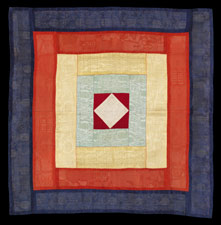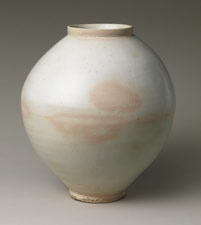New Connections appear every Wednesday. Sign up for a reminder.
Korean art curator Soyoung Lee reflects on the appeal of abstraction, found everywhere from her children's artwork to that of modern masters.
 1280852
1280852 1280926
1280926 10371024
10371024 7891024
7891024 9601024
9601024 10261024
10261024 6991024
6991024 10511024
10511024 10061024
10061024 1280818
1280818 862994
862994 1280996
1280996 4601024
4601024 7241024
7241024 5651024
5651024 9131024
9131024 9131024
9131024 9131024
9131024 9131024
9131024 1280852
1280852
My name is Soyoung Lee. I'm a curator here at the Metropolitan Museum, and I am responsible for the Korean art collection and gallery, and my topic is abstraction.
I have two children. Henry is 8, and Audrey is 6, and like all children they love to draw and you know a lot of abstract artists'
works are characterized as naive or childlike in a very positive sense and I think that's the strength of children.
Because they don't grasp the real world the way that we can, they're actually in many ways better to see the essential qualities.
And there are artists like Klee, who can so delicately and elegantly express a lot with just a few color strokes, with shapes, and yet at the same time retain some sort of realistic sense of the place.
Even though they can seem so stripped bare. For example, the Homage to [the]Square, it's just blue and green squares. Why should that be appealing?
And yet I think geometric patterns, things that are reduced to the essentials, the viewer brings just as much to the meaning of the art as the artist, so you're in many ways participating in the creation of what it means and what the emotional depth of the artwork is.
And of course it also reminds me something that I'm very familiar with, which is patchwork in Korean art. These were not art per se. They were made from discarded pieces of clothing
to make something that was both practical and beautiful. They very much look a lot like Mondrian. And lots of people comment on that, actually make that connection.
When you look at ancient pottery, in different cultures, perhaps the most striking thing is how
they're all very visually and emotionally powerful because they get down to the
very basic forms and lines. It has nothing to do with realistic depictions of anything we might find around us.
We tend to equate, in Western culture, realism with lifelike or naturalistic renderings of the subject matter. But in abstract
art, where there are no realistic depictions, the lines, the geometric forms, and the abstraction makes them incredibly dynamic.
There are many things actually in the Museum that are accidental abstractions. This head of a woman. The face has been eroded and so really all you see is the egg-shaped head, the beautiful tubular neck, and a hint of an eyebrow and a chipped nose. Though this is not the intended result of the creator, of the artist, in fact what we today see is in some ways perhaps more evocative and I think more emotionally resonant.
What I've come to develop or come to realize is that, in fact, abstraction is very much a part of Korean art and it's this classical restraint and minimalism in traditional Korean art
that resonates with modern and contemporary art and audiences. The moon Jar
it in many ways doesn't represent anything; at the same time it's incredibly evocative of the full moon.
But I think there's that sense of ambiguity which is what is so appealing about abstract art to some people and perhaps what's frustrating about abstract art
to others.
 |
 |
 |
 |
 |
 |
 |
 |
 |
 |
 |
 |
 |
Works of art in order of appearanceLast Updated: June 22, 2015. Not all works of art in the Museum's collection may be on view on a particular day. For the most accurate location information, please check this page on the day of your visit. |
||
 |
Black Reflections 1959 Franz Kline (American) Oil and pasted paper on paper, mounted on Masonite Gift of Mr. and Mrs. Norman Schneider, 1964 (64.146) © 2011 The Franz Kline Estate / Artists Rights Society (ARS), New York More information: The Collection Online Not on view
|
 Modern and Contemporary ArtSecond Floor
Modern and Contemporary ArtSecond Floor |
 |
Hammamet with Its Mosque 1914 Paul Klee (German, born Switzerland) Watercolor and pencil on paper The Berggruen Klee Collection, 1984 (1984.315.4) © 2011 Artists Rights Society (ARS), New York / VG Bild-Kunst, Bonn More information: The Collection Online Not on view
|
 Modern and Contemporary ArtSecond Floor
Modern and Contemporary ArtSecond Floor |
 |
Homage to the Square: Soft Spoken 1969 Josef Albers (American, born Germany) Oil on Masonite Gift of the artist, 1972 (1972.40.7) © 2011 The Josef and Anni Albers Foundation / Artists Rights Society (ARS), New York More information: The Collection Online Not on view
|
 Modern and Contemporary ArtSecond Floor
Modern and Contemporary ArtSecond Floor |
 |
Static-Dynamic Gradation 1923 Paul Klee (German, born Switzerland) Oil and gouache on paper, bordered with gouache, watercolor, and ink The Berggruen Klee Collection, 1987 (1987.455.12) © 2011 Artists Rights Society (ARS), New York / VG Bild-Kunst, Bonn More information: The Collection Online Not on view
|
 Modern and Contemporary ArtSecond Floor
Modern and Contemporary ArtSecond Floor |
 |
Patchwork Bojagi (Wrapping Cloth) ca. 1950–80 Unidentified Artist (Korean) Silk Purchase, Friends of Asian Art Gifts, 2007 (2007.149) More information: The Collection Online Not on view
|
 Asian ArtSecond Floor
Asian ArtSecond Floor |
 |
Patchwork Bojagi (Wrapping Cloth) ca. 1950–80 Unidentified Artist (Korean) Silk Purchase, Friends of Asian Art Gifts, 2007 (2007.150) More information: The Collection Online Not on view
|
 Asian ArtSecond Floor
Asian ArtSecond Floor |
 |
Kernos (vase for multiple offerings), Jar, Jug ca. 2300–2200 b.c.; Early Cycladic III–Middle Cycladic I Terracotta Purchase, The Annenberg Foundation Gift, 2004 (2004.363.1–3) More information: The Collection Online Not on view
|
 Greek and Roman ArtFirst Floor and Mezzanine
Greek and Roman ArtFirst Floor and Mezzanine |
 |
Jar Majiayao culture, Machang phase, ca. 2300–2050 b.c. Gansu or Qinghai Province, China Earthenware with painted decoration Charlotte C. and John C. Weber Collection, Gift of Charlotte C. and John C. Weber (1992.165.8) More information: The Collection Online Not on view
|
 Asian ArtSecond Floor
Asian ArtSecond Floor |
 |
Three female figures ca. 1400–1300 b.c.; Late Helladic IIIA Mycenaean Terracotta Fletcher Fund, 1935 (35.11.16–.18) More information: The Collection Online Not on view
|
 Greek and Roman ArtFirst Floor and Mezzanine
Greek and Roman ArtFirst Floor and Mezzanine |
 |
Kouros 1944–45 Isamu Noguchi (American) Marble Fletcher Fund, 1953 (53.87a–i) © 2011 The Isamu Noguchi Foundation and Garden Museum, New York / Artists Rights Society (ARS), New York More information: The Collection Online Not on view
|
 Modern and Contemporary ArtSecond Floor
Modern and Contemporary ArtSecond Floor |
 |
Bird in Space 1923 Constantin Brancusi (French, born Romania) Marble Bequest of Florene M. Schoenborn, 1995 (1996.403.7ab) © 2011 Artists Rights Society (ARS), New York / ADAGP, Paris More information: The Collection Online Not on view
|
 Modern and Contemporary ArtSecond Floor
Modern and Contemporary ArtSecond Floor |
 |
Head from the figure of a woman ca. 2700–2500 b.c.; Early Cycladic I–II Cycladic; Keros-Syros culture Marble Gift of Christos G. Bastis, 1964 (64.246) More information: The Collection Online Not on view
|
 Greek and Roman ArtFirst Floor and Mezzanine
Greek and Roman ArtFirst Floor and Mezzanine |
 |
Jar Joseon dynasty, second half of 18th century Korea White porcelain The Harry G. C. Packard Collection of Asian Art, Gift of Harry G. C. Packard, and Purchase, Fletcher, Rogers, Harris Brisbane Dick and Louis V. Bell Funds, Joseph Pulitzer Bequest, and The Annenberg Fund Inc. Gift, 1979 (1979.413.1) More information: The Collection Online Not on view
|
 Asian ArtSecond Floor
Asian ArtSecond Floor |
© 2011 The Metropolitan Museum of Art |
||






